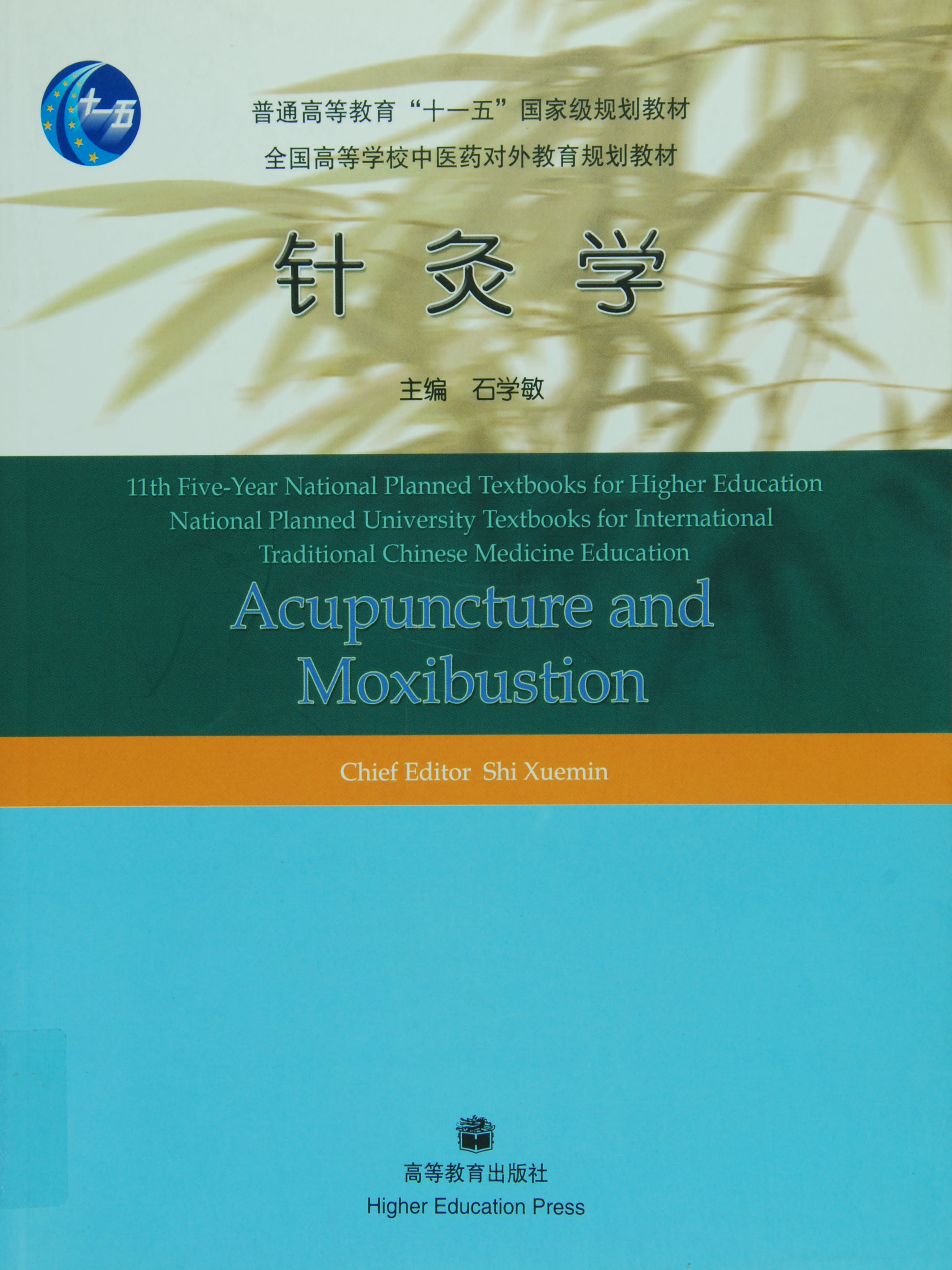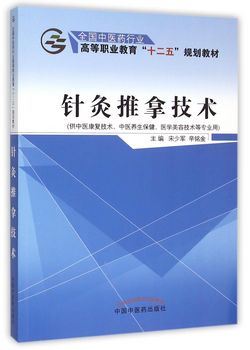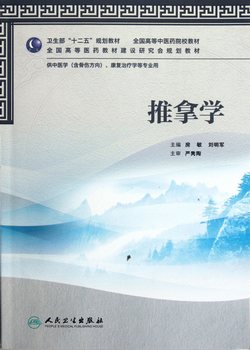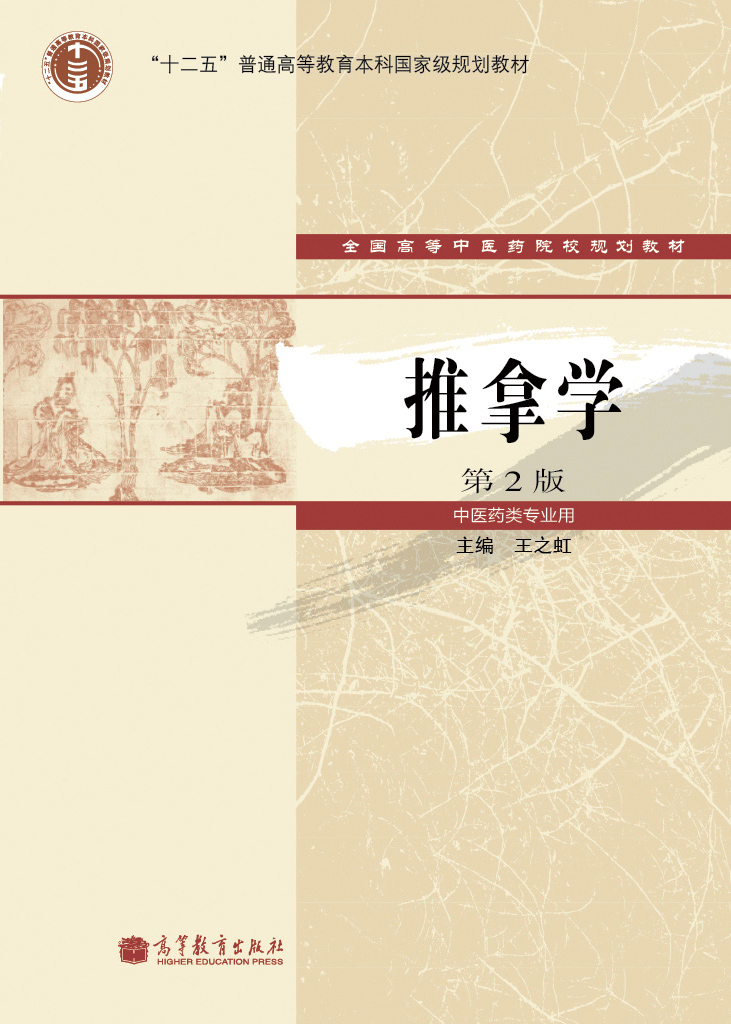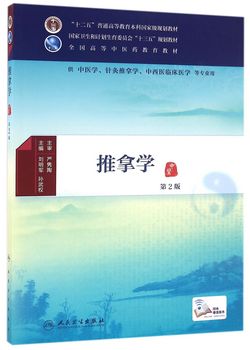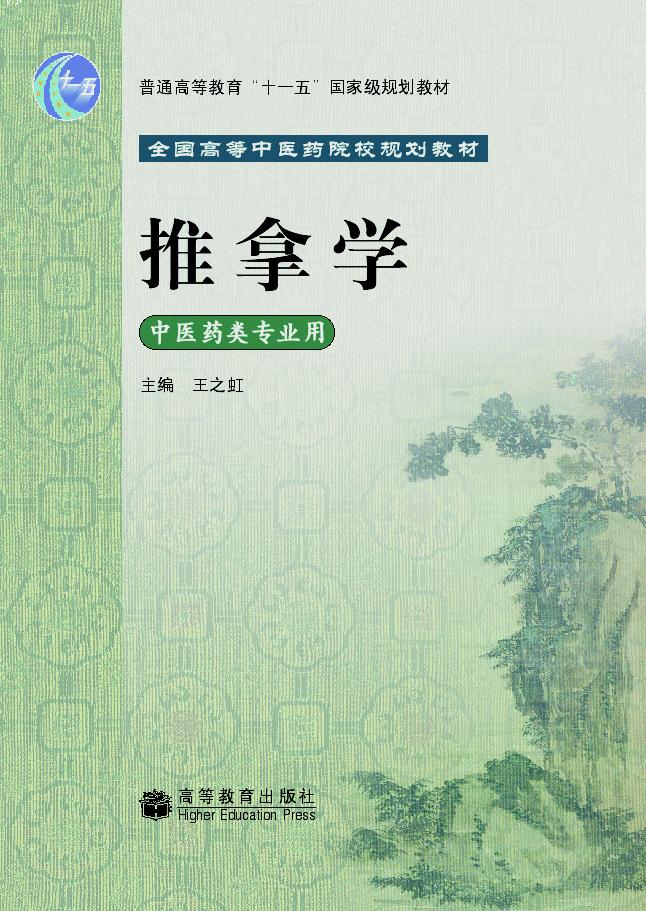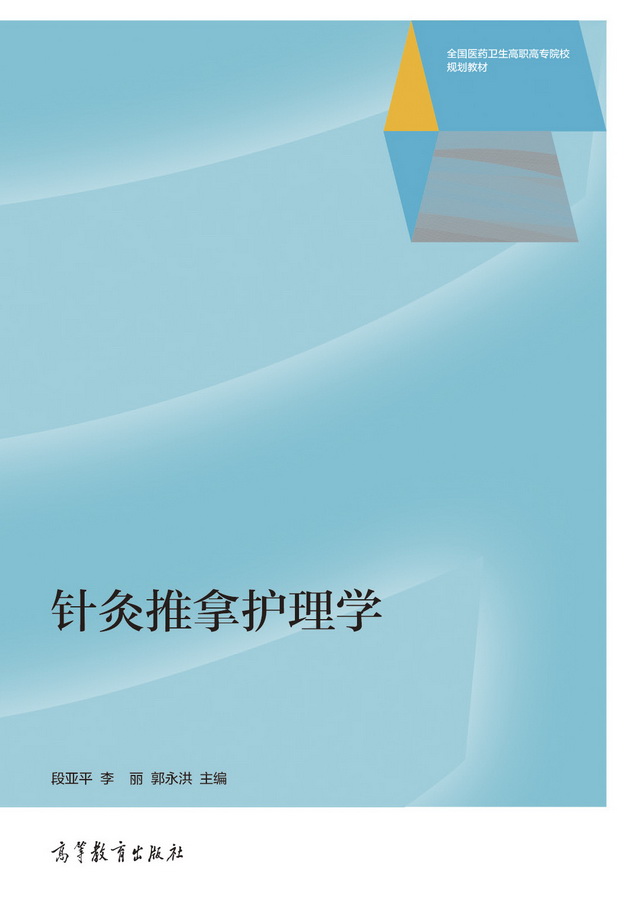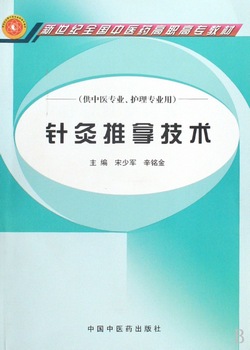- 高等教育出版社
- 9787040205534
- 1
- 245983
- 平装
- 16开
- 2007-06-10
- 1230
- 733
- 医学
- 中医学
本书为普通高等教育“十一五”国家级规划教材,由著名针灸学家、中国工程院院士石学敏教授任主编,全国12所中医院校的针灸专家共同编写完成。
全书由绪言、上篇、中篇、下篇四部分组成。绪言简要介绍了针灸学的定义和发展简史。上篇为针灸基础理论,介绍了经络腧穴。中篇为刺灸法,介绍了常见刺灸法的基本操作。下篇为针灸治疗,以西医病名为纲介绍了常见病的中医辨证、针灸治疗。
本书概念准确,简明扼要,突出实用,适用于接受中医药教育的海外学生(包括接受学历教育的学生及短期班学生),国内学生的双语教学以及国内外研究中医药的学者。
绪言
上篇 经络腧穴
第一章 经络总论
第一节 经络系统的组成
一、十二经脉
二、奇经八脉
三、十二经别
四、十五络脉
五、十二经筋
六、十二皮部
第二节 经络的标本、根结、气街、四海
一、标本与根结
二、气街
三、四海
第三节 经络的生理功能和病理变化
一、经络的生理功能
二、经络的病理变化
第四节 经络学说的临床应用
一、诊断
二、治疗
第二章 腧穴总论
第一节 腧穴的分类和命名
一、腧穴的分类
二、腧穴的命名
第二节 腧穴的作用及主治规律
一、腧穴的作用
二、腧穴的主治规律
第三节 特定穴
一、特定穴的意义
二、特定穴的分类和特点
第四节 腧穴的定位取穴方法
一、体表解剖标志定位法
二、骨度折量法
三、简便定位取穴法
四、手指同身寸定位取穴法
第三章 经络腧穴各论
第一节 十二经脉和腧穴
一、手太阴肺经
二、手阳明大肠经
三、足阳明胃经
四、足太阴脾经
五、手少阴心经
六、手太阳小肠经
七、足太阳膀胱经
八、足少阴肾经
九、手厥阴心包经
十、手少阳三焦经
十一、足少阳胆经
十二、足厥阴肝经
第二节 奇经八脉和腧穴
一、任脉
二、督脉
三、冲脉
四、带脉
五、阴维脉
六、阳维脉
七、阴跷脉
八、阳跷脉
第三节 常用奇穴
一、头颈部穴
二、胸背部穴
三、上肢部穴
四、下肢部穴
中篇 刺灸法
第四章 刺灸法总论
第一节 刺灸法的定义与作用
第二节 刺灸法的源流
一、针刺的起源与发展
二、灸法的起源和发展
第三节 刺灸法的原则
一、治神
二、守气
第四节 刺法及灸法操作的量学要素
一、刺法的量学要素
二、灸法的量学要素
第五章 刺法灸法各论
第一节 毫针刺法
一、毫针的构造、规格、检查和保藏
二、毫针刺法的练习
三、针刺前的准备
四、毫针刺法
五、行针和得气
六、针刺补泻手法
七、留针与出针
八、异常情况的处理和预防
九、针刺注意事项
第二节 灸法
一、灸法的作用
二、灸法的种类、方法和应用
三、施灸的注意事项
第三节 拔罐法
一、罐的种类
二、罐的吸附方法
三、拔罐的应用
四、拔罐的作用和适用范围
五、起罐方法和注意事项
第四节 三棱针法、皮肤针法、皮内针法、电针法、穴位注射法
一、三棱针法
二、皮肤针法
三、皮内针法
四、电针法
五、穴位注射法
第五节 头针
一、标准头穴线的定位和主治
二、头针的适应证
三、头针的操作方法
四、注意事项
第六节 耳针
一、耳与经络脏腑的关系
二、耳廓表面解剖
三、耳穴的分布
四、耳穴的部位和主治
五、耳穴的临床应用
下篇 针灸治疗
第六章 治疗总论
第一节 针灸的作用
一、疏通经络
二、调和阴阳
三、扶正祛邪
第二节 针灸作用的基本特点及其影响因素
一、针灸作用的基本特点
二、影响针灸作用的因素
第三节 针灸治疗原则
一、三因制宜
二、调整阴阳
三、扶正祛邪
四、标本缓急
五、局部与整体
第四节 针灸临床诊治特点
一、辨证与辨经结合
二、辨证与辨时结合
三、调神与调气并重
第五节 针灸处方
一、选穴原则
二、配穴方法
三、刺灸方法的选择
第六节 特定穴的内容和应用
一、五输穴的内容和应用
二、原穴、络穴及其应用
三、俞穴、募穴及其应用
四、八脉交会穴及其应用
五、八会穴及其应用
六、郄穴及其应用
七、下合穴及其应用
八、交会穴的内容和应用
第七章 治疗各论
第一节 急症
一、高热
二、抽搐(痉证)
三、休克
四、心绞痛
五、胃绞痛
六、胆绞痛
七、肾绞痛
第二节 内科疾病
一、上呼吸道感染
二、急性支气管炎
三、慢性支气管炎
四、支气管哮喘
五、高血压
六、心律失常
七、冠状动脉粥样硬化性心脏病
八、脑梗死
九、脑出血
十、老年性痴呆
十一、癲痫
十二、周围性面神经麻痹
十三、三叉神经痛
十四、坐骨神经痛
十五、肌营养不良
十六、头痛
十七、神经衰弱
十八、抑郁性精神病
十九、急性胃炎
二十、慢性胃炎
二十一、消化性溃疡
二十二、胃下垂
二十三、顽固性呃逆
二十四、神经性呕吐
二十五、急、慢性肠炎
二十六、非特异性结肠炎
二十七、功能性便秘
二十八、细菌性痢疾
二十九、脱肛
三十、胆结石
三十一、泌尿道感染
三十二、非梗阻性尿潴留
三十三、性功能障碍
三十四、男性不育症
三十五、风湿和类风湿性关节炎
三十六、肥胖症
第三节 皮外骨伤科疾病
一、急性腰扭伤
二、慢性腰肌劳损
三、落枕
四、颈椎病
五、腰椎间盘突出症
六、周围神经损伤
七、外伤性截瘫
八、腱鞘囊肿
九、肩关节周围炎
十、寻常痤疮
十一、荨麻疹
十二、丹毒
十三、带状疱疹
十四、疗疮
十五、脱发
十六、神经性皮炎
十七、寻常疣
第四节 妇儿科疾病
一、月经紊乱
二、功能失调性子宫出血
三、痛经
四、闭经
五、宫颈炎
六、子宫脱垂
七、围绝经期综合征
八、乳腺增生
九、子宫阵缩无力
十、胎位不正
十一、不孕
十二、小儿惊厥
十三、小儿遗尿
十四、小儿消化不良
十五、小儿脑瘫
十六、小儿多动症
第五节 五官科疾病
一、结膜炎
二、鼻窦炎
三、过敏性鼻炎
四、牙痛
五、急性扁桃体炎
六、急、慢性咽炎
七、假性近视
彩图
Introduction
Part One General Introduction to Meridians and Acupoints
Chapter 1 Meridians and Collaterals
1.1 The Composition of the System of the Meridians and Collaterals
1.1.1 The Twelve Main Meridians
1.1.2 The Eight Extra Meridians
1.1.3 The Twelve Divergent Meridians
1.1.4 Fifteen Main Collaterals
1.1.5 Muscles along Twelve Meridians
1.1.6 The Twelve Cutaneous Regions
1.2 Biao Ben,Gen Jie,Qi Jie (the Pathway of Qi) and Si Hai (the Four Seas) of Meridians and Collaterals
1.2.1 Biao Ben and Gen Jie
1.2.2 Qi Jie
1.2.3 SiHai
1.3 The Physiological Functions and Pathological Changes of the Meridians and Collaterals
1.3.1 The Physiological Functions of the Meridians and Collaterals
1.3.2 The Pathological Changes in the Meridians and Collaterals
1.4 The Clinical Applications of the Theory of the Meridians and Collaterals
1.4.1 Diagnosis
1.4.2 Treatment
Chapter 2 General Introduction to Acupoints
2.1 The Classification and Nomenclature of the Acupoints
2.1.1 Classification of the Acupoints
2.1.2 The Nomenclature of the Acupoints
2.2 Function and Indication Laws of the Acupoints
2.2.1 The Functions of Acupoints
2.2.2 The Law of Indications of Acupoints
2.3 Specific Points
2.3.1 The Meaning of Specific Points
2.3.2 The Classification and Characteristics of Specific Points
2.4 Methods of Locating Acupoints
2.4.1 Locating Points by Anatomical Landmarks
2.4.2 Locating Points by Proportional Bone Measurement
2.4.3 The Simple Way of Locating Points
2.4.4 Finger-Cun Measurements
Chapter 3 Meridians and Their Acupoints
3.1 The Twelve Main Meridians and Their Acupoints
3.1.1 Long (LU) Meridian of Hand Taiyin
3.1.2 Large Intestine (LI) Meridian of Hand Yangming
3.1.3 The Stomach (ST) Meridian of Foot Yangming
3.1.4 Spleen (SP) Meridian of Foot Taiyin
3.1.5 Heart (HT) Meridian of Hand Shaoyin
3.1.6 Small Intestine (SI) Meridian of Hand Taiyang
3.1.7 Bladder (BL) Meridian of Foot Taiyang
3.1.8 The Kidney (KI) Meridian of Foot Shaoyin
3.1.9 Pericardium (PC) Meridian of Hand Jueyin
3.1.10 Triple Energizer (TE) Meridian of Hand Shaoyang
3.1.11 Gallbladder (GB) Meridian of Foot Shaoyang
3.1.12 Liver (LR) Meridian of Foot Jueyin
3.2 The Eight Extra Meridians and Their Acupoints
3.2.1 Conception Vessel
3.2.2 Governor Vessel
3.2.3 The Thoroughfare Vessel
3.2.4 The Belt Vessel
3.2.5 The Yin Link Vessel
3.2.6 The Yang Link Vessel
3.2.7 The Yin Heel Vessel
3.2.8 The Yang Heel Vessel
3.3 The Frequently Used Extraordinary Acupoints
3.3.1 Acupoints of the Head and Neck (EX-HN)
3.3.2 Acupoints of the Back (EX-B)
3.3.3 Acupoints of the Upper Extremities (EX-UE)
3.3.4 Acupoints of the Lower Extremities (EX-LE)
Part Two Needling and Moxibustion Techniques
Chapter 4 General Introduction to Needling and Moxibustion Techniques
4.1 Concepts and Functions of Needling and Moxibustion Techniques
4.2 Origin and Development of Needling and Moxibustion Techniques
4.2.1 The Origin and Development of Acupuncture Techniques
4.2.2 The Origin and Development of Moxibustion Techniques
4.3 Principles of needling and Moxibustion Techniques
4.3.1 Cultivating Shen
4.3.2 Maintaining Qi
4.4 Quantitative Factors of Acupuncture and Moxibustion Techniques
4.4.1 Quantitative Factors of Acupuncture Technique
4.4.2 Quantitative Factors of Moxibustion Techniques
Chapter 5 Acupuncture and Moxibustion Techniques
5.1 Acupuncture Techniques of Filiform Needle
5.1.1 Structure,Specifications,Inspection and Storage of Filiform Needles
5.1.2 Needling Practice
5.1.3 Preparation
5.1.4 Acupuncture Techniques
5.1.5 Manipulations and the Arrival of Qi (Needling Sensation)
5.1.6 The Reinforcing (Tonification) and Reducing (Dispersal) Methods of Acupuncture
5.1.7 The Retention and Withdrawal of Needles
5.1.8 Management and Prevention of Accidents
5.1.9 Acupuncture Treatment Precautions
5.2 Moxibustion
5.2.1 The Functions of Moxibustion
5.2.2 Classification,Manipulation and Application of Moxibustion
5.2.3 Precautions
5.3 Cupping Therapy (Ba Guan Liao Fa)
5.3.1 Types of Cups
5.3.2 Methods of Creating Suction Inside the Cup
5.3.3 Application of Cupping
5.3.4 The Actions and Indications for Cupping
5.3.5 Cup Removal and Precautions
5.4 Therapies for Three-Edged,Skin and Intradermal Needles,Electro-acupuncture and Point Injection
5.4.1 Three-Edged Needling Therapy (San Leng Zhen Fa)
5.4.2 Skin Needling Therapy (Pi Fu Zhen Fa)
5.4.3 Intradermal Needling Therapy (Pi Nei Zhen Fa)
5.4.4 Electro-Acupuncture Therapy (Dian Zhen Fa)
5.4.5 Point Injection Therapy (Xue Wei Zhu She Fa)
5.5 Scalp Acupuncture (Tou Zhen)
5.5. 1 Standard Scalp Acupuncture Locations and Indications
5.5.2 Indications for Scalp Acupuncture Therapy
5.5.3 Manipulations Methods
5.5.4 Precautions
5.6 Ear Acupuncture Therapy (Er Zhen Liao Fa)
5.6.1 The Relationship between the Ears,Meridians and the Zang Fu Organs
5.6.2 Auricular Surface Anatomy
5.6.3 Auricular Point Distribution
5.6.4 Auricular Point Locations and Indications
5.6.5 Clinical Applications of Auricular Points
Part Three Acupuncture and Moxibustion Treatments
Chapter 6 A General Introduction to Treatments
6.1 The Functions of Acupuncture and Moxibustion
6.1.1 Dredging the Meridians
6.1.2 Regulating Yin and Yang
6.1.3 Strengthening the Body's Resistance and Eliminating Pathogenic Factors
6.2 Basic Characteristics and Influential Factors of Acupuncture and Moxibustion
6.2.1 The Basic Characteristics of the Effects of Acupuncture and Moxibustion
6.2.2 Factors that Influence the Effects of Acupuncture and Moxibustion
6.3 Therapeutic Principles of Acupuncture and Moxibustion
6.3.1 The Three Etiological Categories
6.3.2 Regulating Yin and Yang
6.3.3 Strengthening Body Resistance and Expelling Pathogenic Factors
6.3.4 Root and Branch
6.3.5 The Local Area and the Whole Body
6.4 Clinical Diagnoses and Treatments with Acupuncture and Moxibustion
6.4.1 Syndrome and Meridian Differentiation
6.4.2 The Combination of Syndrome and Time Differentiation
6.4.3 Shen and qi Regulation
6.5 Acupuncture and Moxibustion Prescriptions
6.5.1 Principles of Acupoints Selection
6.5.2 Acupoint Combinations
6.5.3 The Selection of Acupuncture and Moxibustion Techniques
6.6 Special Acupoints
6.6.1 The Five Transport Point (Wu Shu Xue) and Applications
6.6.2 Yuan-Source and Luo-Connecting Acupoints
6.6.3 Back Transport (Bei Shu Xue) and Alarm Points (Mu Xue)
6.6.4 Eight Confluent Points (Ba Mai Jiao Hui Xue)
6.6.5 Eight Influential Acupoints (Ba Hui Xue)
6.6.6 Cleft Acupoints (Xi Xue)
6.6.7 Lower Sea Acupoints (Xia He Xue)
6.6.8 Crossing Acupoints (Jiao Hui Xue)
Chapter 7 Specific Discussions of Treatments
7.1 Emergencies
7.1.1 High Fever
7.1.2 Convulsions
7.1.3 Shock
7.1.4 Angina Pectoris
7.1.5 Stomach Colic
7.1.6 Gallbladder Colic
7.1.7 Renal Colic
7.2 The Internal Diseases
7.2.1 Upper Respiratory Track Infection
7.2.2 Acute Bronchitis
7.2.3 Chronic Bronchitis
7.2.4 Bronchial Asthma
7.2.5 Hypertensive Disease
7.2.6 Cardiac Arrhythnuas
7.2.7 Coronary Atherosclerotic Heart Disease
7.2.8 Cerebral Infarction
7.2.9 Cerebral Hemorrhage
7.2.10 Senile Dementia
7.2.11 Epilepsy
7.2.12 Peripheral Facial Nerve Paralysis
7.2.13 Trigeminal Neuralgia
7.2.14 Sciatica
7.2.15 Myodystrophy/Muscular Dystrophy
7.2.16 Headache
7.2.17 Neurasthenia
7.2.18 Depressive Psychosis
7.2.19 Acute Gastritis
7.2.20 Chronic Gastritis
7.2.21 Peptic Ulcer
7.2.22 Gastroptosis
7.2.23 Intractable Hiccups
7.2.24 Neurotic Vomiting
7.2.25 Acute and Chronic Enterifis
7.2.26 Nonspecific Colitis
7.2.27 Functional Constipation
7.2.28 Bacillary Dysentery
7.2.29 Rectocele
7.2.30 Cholelithiasis
7.2.31 Urinary Tract Infection
7.2.32 Non-Obstructive Urinary Retention
7.2.33 Sexual Dysfunction
7.2.34 Male Infertility
7.2.35 Rheumatic and Rheumatoid Arthritis
7.2.36 Obesity
7.3 Musculo-Skeletal Injuries and Diseases of Dermatological Surgery
7.3.1 Acute Waist Sprains
7.3.2 Chronic Lumbar Muscle Strain
7.3.3 Stiff Neck
7.3.4 Cervical Spondylopathy
7.3.5 Prolapse of the Lumbar Intervertebral Disc
7.3.6 Peripheral Neuropathy/Nerve Damage
7.3.7 Traumatic Paraplegia
7.3.8 Intrathecal/Ganglionic Cyst
7.3.9 Scapulo-Humeral Periarthritis
7.3.10 Common Acne
7.3.11 Urticaria/Hives
7.3.12 Erysipelas
7.3.13 He rpes Zoster
7.3.14 Furuncles
7.3.15 Alopecia
7.3.16 Neurodermafitis
7.3.17 Common Warts
7.4 Diseases of Gynecology and Pediatrics
7.4.1 Irregular Menstruation
7.4.2 Dysfunctional Uterine Bleeding
7.4.3 Dysmenorrhea
7.4.4 Amenorrhea
7.4.5 Cervicitis
7.4.6 Metroptosis/Uterine Prolapse
7.4.7 Peri-Menopausal Syndrome
7.4.8 Hyperplasia of the Mammary Glands
7.4.9 Uterine Inertia
7.4.10 Malposition of the Fetus
7.4.11 Sterility
7.4.12 Infantile Convulsions
7.4.13 Infantile Enuresis
7.4.14 Infantile Indigestion
7.4.15 Infantile Cerebral Palsy
7.4.16 Infantile Hyperactive Syndrome
7.5 The Five Sense Organs
7.5.1 Conjunctivitis
7.5.2 Naso-Sinusitis
7.5.3 Allergic Rhinitis
7.5.4 Pulpitis/Toothache
7.5.5 Acute Tonsillitis
7.5.6 Acute and Chronic Pharyngitis
7.5.7 Pseudomyopia
Colored Picture

